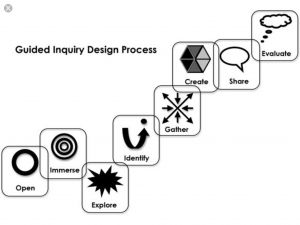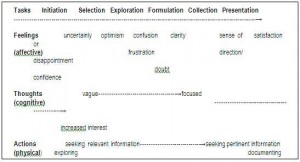A comparison of Kuhlthau’s Inquiry Models and the 8W’s Model.
The Guided Inquiry Design Process Model by Kuhlthau has 8 stages of Inquiry: 1) Open 2) Immerse 3) Explore 4) Identify 5) Gather 6) Create 7) Share and 8) Evaluate.
The Information Search Process Model by Kuhlthau has 7 stages of Inquiry: 1) Initiation 2) Selection 3) Exploration 4) Formulation 5) Collection 6) Presentation and 7) Assessment.
The 8W’s has 8 stages of Inquiry: 1) Watching 2) Wondering 3) Webbing 4) Wiggling 5) Weaving 6) Wrapping 7) Waving and 8) Wishing.
Kuhlthau’s Inquiry Models both start the inquiry process with Open and Initiation which presents the topic. This ‘catches the students’ attention and help them make connections with the world outside of school.’ (Kuhlthau; Maniotes & Caspari, 2012) The 8W’s Model starts off the inquiry process with (Watching (Exploring)) in a similar manner as ‘it asks students to become more in tune to the world around them’ (Lamb; Johnson & Smith, 1997) like the Kuhlthau Models do.
The 8W’s Model then moves on to Wondering (Questioning). This is the questioning stage of the process. This stage of the models by Kuhlthau are Immerse and Selection. All the models at this point seem to be quite similar. Each of the models at this stage are trying to get students to connect to the topic and in doing so they are discussing ideas, identifying problems and developing questions. Kuhlthau mentions emotions whilst at each stage, does not seem to following this kind of learning throughout it’s process.
The third stage of inquiry in the Kuhlthau Models are Explore and Exploration where in the 8W’s it is Webbing (Searching). They both involve students searching for and connecting ideas about information. Lamb; Johnson & Smith (1997) talk about students selecting resources that are relevant and organising them into meaningful clusters. Kuhlthau (2007) mentions that for most students, this is the most difficult stage of the process as it requires them to search when they may not really know how to. It can lead to frustration and some time discouragement.
The terms used by Kuhlthau and the 8W’s Models are Formulation, Identify and Wiggling (Evaluating) for the fourth stage. All seem quite different in their meaning for this stage. The 8W’s Model talks about this stage as being the toughest for students because they are often uncertain about their findings and where they’re going with the inquiry. In the Kuhlthau Models this seems to be the stage where the students are asked to pause and work out a focus for their inquiry by formulating questions that will guide them for the remainder of the inquiry. This seems to happen in the Weaving (Synthesising) stage for the 8W’s model. The students organise their ideas and formulate plans to analyse the information they have gathered.
This would then be assumed that the remainder of the models would be a little different at each stage because of this change of stages in the 8W’s Model. Both of the Kuhlthau Models have similar terms used at this point of the inquiry. They use the terms Collection and and Gather. This is where students are looking at what information they have found and working out what is most important to them or what has the most meaning to what they are trying to learn about. The 8W’s Model is similar in the sense that it is Wrapping (Creating) and packaging ideas up to work out what is important.
The last two stages of inquiry in the 8W’s Model is similar to Kuhlthau’s Models of Inquiry as they they are either presenting, sharing, communicating their findings and then they are asked to assess and evaluate their findings. The terms used in the 8W’s model are Waving (Communicating) & Wishing (Assessing) where Kuhlthau uses Share & Evaluate as well as Presentation & Assessment.
Overall the models are quite similar in what occurs at each stage but they use different wording. Kuhlthau mentions more about the emotions of the students through the inquiry process where the 8W’s Model only mentions that the Wiggling stage is the toughest. The 8W’s model would be a useful model to use for students in Middle to Upper Primary School as the wording is ‘quirky’ and ‘catchy’ for the younger children. There seems to not be just one worded stages like the Kuhlthau Models. The model gives one main word that starts with a ‘W’ and then below it another word to describe the ‘W’ word. It also provides the user with what the teacher, the student and the technologies role is in the inquiry. The model seems to provide the user with a fair amount of information that they could use without having to read a great deal of supporting documents or literature. It would be perfect for an in depth inquiry.
References:
Lamb, A.; Johnson, L. & Smith, N. (1997). Wondering, Wiggling, and Weaving: A New Model for Project and Community Based Learning on the Web Learning and Leading With Technology, 24 (7), 6-13.
Kuhlthau, Carol C. ; Maniotes, Leslie K. & Caspari, Ann K, (2007). Chapter 2: The Theory and Research Basis for Guided Inquiry. In Kuhlthau, Carol C. ; Maniotes, Leslie K. & Caspari, Ann K, Guided inquiry : learning in the 21st century, (pp.13 – 28). Westport, Conn: Libraries Unlimited.
Kuhlthau, C.; Maniotes, L. and Caspari, A, (2012). Chapter 1 : Guided Inquiry Design: The Process, the Learning, and the Team. In Kuhlthau, C.; Maniotes, L. and Caspari, A, Guided inquiry design : a framework for inquiry in your school, (pp.1 – 15). Santa Barbara: Libraries Unlimited.


